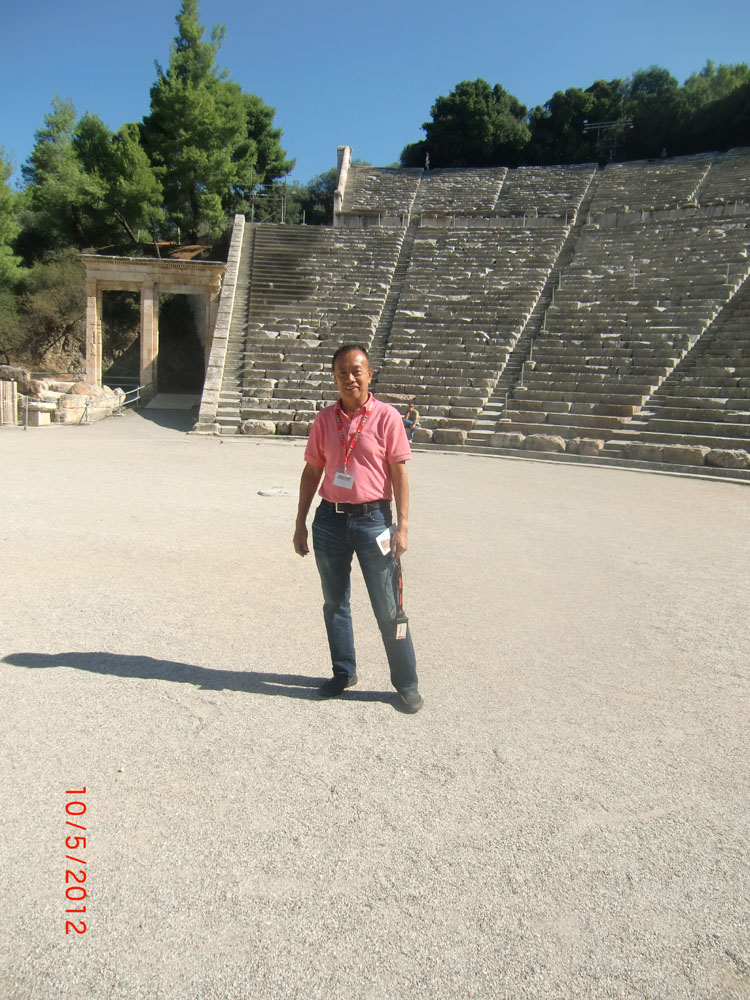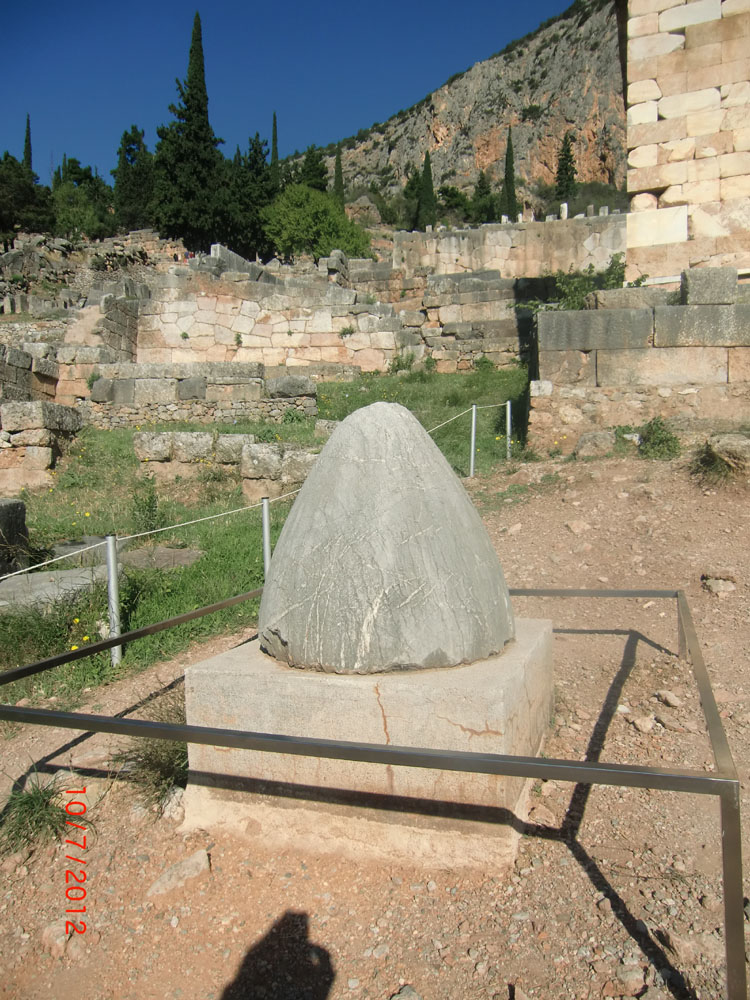Piraeus*Epidaurus*Mycenae*Olympia
Today we disembark from the Louis Cristal in Piraeus and take a tour bus passing through Athens for the scenic coastal road to the Corinth Canal.
 |
 |
Epidaurus
(Greek: Επίδαυρος) was a small city (polis) in ancient Greece. The asclepieion at Epidaurus was the most celebrated healing center of the Classical world, the place where ill people went in the hope of being cured. To find out the right cure for their ailments, they spent a night in the enkoimeteria, a big sleeping hall. In their dreams, Asclepius, the most important healer god of antiquity, would advise them what they had to do to regain their health. Found in the sanctuary, there was a guest house for 160 guestrooms. There are also mineral springs in the vicinity.
 |
 |
 |
The prosperity brought by the Asklepieion enabled Epidaurus to construct civic monuments like the huge theatre, designed by Polykleitos the Younger in the 4th century BC. The original 34 rows were extended in Roman times by another 21 rows. It seats up to 15,000 people and is knowned for its exceptional acoustics, which permit almost perfect intelligibility of unamplified spoken word from the proscenium or skênê to all spectators, regardless of their seating.
 |
 |
 |
 |
 |
Napflio
Lunch today was in Nafplio (Greek: Ναύπλιο), a seaport town in the Peloponnese that has expanded up the hillsides near the north end of the Argolic Gulf. The castle of Bourtzi (Greek: Μπούρτζι meaning "tower") is located in the middle of the harbor of Nafplio. The Venetians completed its fortification in 1473 to protect the city from pirates and invaders from the sea. Above the town is the Palamidi (Greek: Παλαμήδι) Palace, a fortress nestled on the crest of a 216-metre high hill which was built by the Venetians during their second occupation of the area (1686–1715).
 |
 |
Mycenae
Mycenae (Greek Μυκῆναι) is an archaeological site in Greece, located about 90 km southwest of Athens. In the second millennium BC, Mycenae was one of the major centres of Greek civilization, a military stronghold which dominated much of southern Greece. The period of Greek history from about 1600 BC to about 1100 BC is called Mycenaean in reference to Mycenae. The Treasury of Atreus or Tomb of Agamemnon is an impressive "tholos" tomb on the Panagitsa Hill at Mycenae, Greece, constructed during the Bronze Age around 1250 BC. The lintel stone above the doorway weighs 120 tons, the largest in the world. The tomb has probably no relationship with either Atreus or Agamemnon, as archaeologists believe that the sovereign buried there ruled at an earlier date than the two; it was named thus by Heinrich Schliemann and the name has been used ever since. From here we looked at other sites and passed through the best known feature of Mycenae, the Lion Gate.
 |
 |
 |
 |
 |
 |
Checked in at the Arty Grand Hotel atop a hill overlooking Olympia.
October 6
Olympia Archeological Tour
Today we go to the Olympia (Greek: Ολυμπία) archeological site. Olympia, a sanctuary of ancient Greece in Elis, is known for having been the site of the Olympic Games in classical times. The Olympic Games, in honor of Zeus, were held every four years throughout Classical Antiquity, from the 8th century BC to the 4th century AD. The earliest evidence of building activity on the site dates from around 600 BC. Important structures were: Temple of Hera, Temple of Zeus, Philippeion, Palaestra, Leonidaion, Hippodrome, Gymnasion.
 |
 |
 |
 |
The Temple of Zeus had pediments, one depicting the myth of the chariot race between Pelops and Oenomaus, with Zeus standing in the center, flanked by standing pairs of heroes and heroines, and the two chariot groups; and the other depicting the Centauromachy, the fight at the wedding of Peirithoos between the Lapiths and the centaurs, who had violated xenia, the sacred rules of hospitality that support the social norms. Apollo stood in the centre, flanked by Peirithoos and Theseus.
 |
 |
 |
 |
 |
 |
 |
Other notable sculptures were the Nike of Paionos, the Clay Figfure of a Warrior, and Hermes of Praxiteles.
 |
 |
 |
We stopped along the way to Delphi for lunch hosted by a Greek family at their home.
 |
 |
Checked it at the beautiful Amalia Hotel in Delphi.
 |
 |
Went to the Filellinon area of Delphi to the Ixor Bar for a nightcap.
 |
 |
October 7
Delphi Archaeological Site
Delphi (Greek: Δελφοί), an archaeological site and a UNESCO World Heritage Site, is perhaps best known for the oracle at the sanctuary that was dedicated to Apollo during the classical period. Apollo spoke through his oracle: the sibyl or priestess of the oracle at Delphi was known as the Pythia. It became a major site for the worship of the god Apollo after he slew Python, a dragon who lived there and protected the navel of the Earth. The museum have impressive sculptures like the Charioteer, Nike of Paionos, and Antinoos.
 |
 |
 |
 |
 |
 |
 |
 |
Walked on the site and saw the ruins of the Temple of Apollo, the Treasury of the Athenians, the theatre, the Sanctuary of Athena Pronaia.
 |
 |
 |
 |
 |
 |
 |
Had a nice squid lunch at a local Greek restaurant and walked on the beach afterwards.
 |
 |
We next visited a factory that made beautiful handpainted icons.
We drove on to Kalambaka to another Amalia Hotel which is in the shadows of Meteora.
 |
 |
October 8
Meteora*Athens
The Metéora (Greek: Μετέωρα, meaning "suspended in the air"), included on the UNESCO World Heritage List, is one of the largest and most important complexes of Eastern Orthodox monasteries in Greece, second only to Mount Athos. The six monasteries were built on natural sandstone rock pillars, at the northwestern edge of the Plain of Thessaly. First stop was the Grand Meteoron Monastery.

 |
 |
 |
 |
 |
 |
We went next to the Holy Trinity Monastery. The monastery was featured in the 1981 James Bond film, For Your Eyes Only.
 |
 |
 |
 |
 |
Lunch was in the town of Kalambaka at the Meteora Restaurant.
 |
 |
On the way back to Athens we stopped at the monument which commemorates the Battle of Thermopylae where Leonidas lead 300 Spartans against the Persian army of Xerxes.
 |
 |
 |
 |
Arrived in Athens amid some demonstrations so we were diverted to the Royal Olympic Hotel, which was much better because it was much closer to the Acropolis. Had a wonderful dinner at the roof garden Ioannis Restaurant which offered spectacular views of the Acropolis, Temple of Zeus and the National Gardens.
 |
 |
October 9
Athens
Athens (Greek: Αθήνα) is the capital and largest city of Greece. One of the world's oldest cities, with its recorded history spanning around 3,400 years, it dominates the Attica region. A center for the arts, learning and philosophy, home of Plato's Academy and Aristotle's Lyceum, it is widely referred to as the cradle of Western civilization and the birthplace of democracy. This morning we will have a bus tour of the city then visit the Acropolis and the Museum

 |
 |
 |
 |
From the Acropolis we went to the Acropolis Museum then I had lunch at one of the outdoor restaurants below the Acropolis. Went back to the hotel and had cocktails with Marleen and Gary in the Ioannis Bar and enjoyed the panoramic view from the roof garden. We later had a very good dinner at a local restaurant which also had a wonderful view of the Acropolis.

 |
 |
October 10
Athens*New York
After breakfast I wandered around Athens one more time before my pick-up for the airport. What a very nice trip!

No comments:
Post a Comment